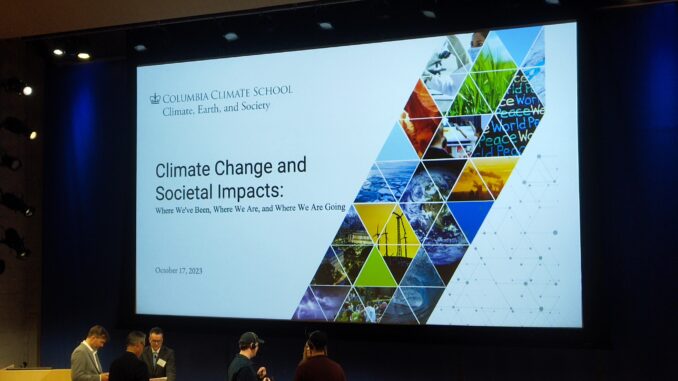
BY JOSH NARISMA
Leading climate scientists gathered at The Forum at Columbia University on October 17 to discuss the increased vulnerability of marginalized groups when encountering climate change. The conference was first in a series of Fall 2023 events hosted by the Columbia Climate School, a multidisciplinary program, to address the driving factors behind environmental disasters and their effects on humanity’s collective future. From the air quality index surpassing 400 during the Canadian wildfires, to flash flooding caused by recent post-tropical cyclone Ophelia, New York City continues to experience the damaging effects of climate change.
The moderator, Jeffrey Schlegelmilch, research scholar and Director of the National Center for Disaster Preparedness, discussed the importance of addressing social inequality: “This is also an interplay of not only what’s happening in nature, but what’s happening in how we develop, how we build our societies […] What are the inequalities that we build into our society that get expanded in the aftermath of disasters?”
The conference panelists included Alexander de Sherbinin, Kristina G. Douglass, and Radley Horton, who are all researchers and professors at the Columbia Climate School. They are affiliated with the U.S. National Aeronautics and Space Agency and Columbia’s Lamont-Doherty Earth Observatory, among others.
Horton presented worrying statistics revealing that 2023 defies previous expectations of air temperature anomalies, and contained some of the hottest days on record. Horton described humanity as being in an unprecedented era: “It’s a world of feedbacks that we don’t fully understand, it’s a world where we’ve turned up the dial on greenhouse gas emissions, and already changed the planet in such fundamental ways that [it] becomes more difficult to predict what comes next in terms of our frequency of extreme events.”
de Sherbinin added that increased disasters have led to higher numbers of “climate migrants,” people forced to leave communities due to environmental stress. However, de Sherbinin clarified that environmental stress is still one of the lowest reasons for migration: “It’s between 3 and 5%. Overwhelmingly, people are saying economics, jobs, sending money home, family reasons, and also — unfortunately in Central America — violence is also a fairly significant driver with a lot of issues with gangs and narco trafficking in that region.” Although environmental stress is not a major driver of migration, he emphasized that the number of climate migrants is expected to increase in coming years. Climate change remains a significant problem in places like Central America, which experienced “tropical cyclones, heavy precipitation and flooding events, and severe multi-year droughts […] throughout 2022.”
Schlegelmilch noted examples of climate disasters around the country such as Typhoon Hillary in California and the wildfires of Hawai’i, Louisiana, and Rhode Island. He stated that 2002-2023 witnessed a record-setting number of disasters that totaled over $2 trillion in damages. According to NBC News, Ophelia caused New York’s “wettest day since Hurricane Ida” and led to the suspension of public transportation and the evacuation of at least one school in Brooklyn. The extensive damage caused by these storms is partially attributed to aging infrastructure and a lack of preparation. When Hurricane Sandy struck New York in 2012, it hit nearly 70,000 houses and caused about $19 billion in damage.
According to Douglass, climate change disproportionately affects certain populations such as in southwest Madagascar, where she conducts various archeological studies: “We are relatively buffered here […] in New York City and the surrounding areas, compared to folks who are producing a majority of their own food.” Douglass said that while only 5 million people today exclusively produce their own food, “they’re stewarding the vast majority […] of reservoirs of biodiversity that we have left on the planet — about 85% or more. So they’re incredibly important members of our global society, and they are experiencing some of the heaviest impacts of the climate crisis as we speak.”
When asked by the reporter about historical responses to climate change, Douglass said, “From southwest Madagascar, we see pretty clearly that people set up social networks in a way that was flexible, and they maintained a pretty diverse array of different social connections to communities across the landscape. You can imagine this being really important, for example, if there’s some kind of weather event that impacts people that are directly on the coast, but doesn’t have the same kind of impact for people who are living from cattle herding or other forms of subsistence inland. So it would make sense to establish and maintain those kinds of social relationships so you can barter and exchange, perhaps, when something affects one group but not the other.” Douglass said people still do this today, and can be as simple as visiting relatives across the country for Thanksgiving. This increases the chance of receiving emotional, physical, or financial support in the case of disasters.
Upcoming events at the Columbia Climate School include the Climate & Health 2023 and a seminar by Dr. Dan Amrhein on atmospheric drivers of ocean variability.
